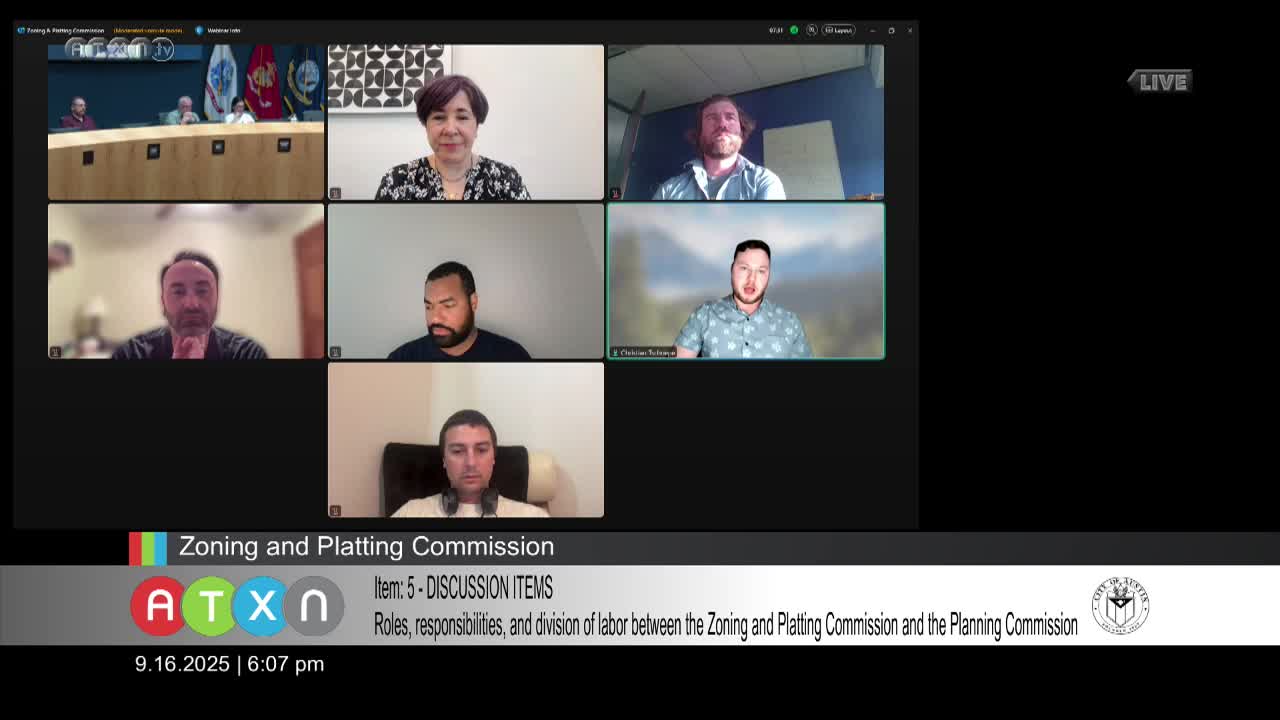Commissioners Consider Revising Joint Committee Structure for Improved Flexibility
September 16, 2025 | Austin, Travis County, Texas
This article was created by AI summarizing key points discussed. AI makes mistakes, so for full details and context, please refer to the video of the full meeting. Please report any errors so we can fix them. Report an error »

During a recent meeting of the Austin Zoning and Platting Commission, discussions centered on improving communication and collaboration between various planning committees. A proposal was put forth to evaluate the current joint committee structure, suggesting that diligent members from each commission could serve as ex officio members on the other. This change aims to enhance context and participation in discussions, fostering a more cohesive planning process.
Commissioner Breton expressed support for the idea, emphasizing a distinction between the roles of the Planning Commission, which would focus on policy, and the Zoning and Platting Commission, which would handle site-specific changes. This division could streamline decision-making and clarify responsibilities.
However, the conversation also highlighted the need for flexibility in handling time-sensitive cases. Some commissioners noted that the current scheduling of meetings can dictate which commission addresses specific issues, suggesting that a more adaptable approach could benefit the process.
Another significant point raised was the potential for sunsetting the joint committee structure altogether. Commissioner Starrett pointed out the ongoing challenges in achieving quorum for the small area planning joint committee, indicating that the committee has struggled to meet regularly. This raises questions about the effectiveness of such committees and whether they still serve a necessary purpose in the planning framework.
As these discussions unfold, the commission is considering how best to enhance its operations while ensuring that community needs are met efficiently. The outcomes of these deliberations could lead to significant changes in how planning decisions are made in Austin, ultimately impacting residents and their neighborhoods.
Commissioner Breton expressed support for the idea, emphasizing a distinction between the roles of the Planning Commission, which would focus on policy, and the Zoning and Platting Commission, which would handle site-specific changes. This division could streamline decision-making and clarify responsibilities.
However, the conversation also highlighted the need for flexibility in handling time-sensitive cases. Some commissioners noted that the current scheduling of meetings can dictate which commission addresses specific issues, suggesting that a more adaptable approach could benefit the process.
Another significant point raised was the potential for sunsetting the joint committee structure altogether. Commissioner Starrett pointed out the ongoing challenges in achieving quorum for the small area planning joint committee, indicating that the committee has struggled to meet regularly. This raises questions about the effectiveness of such committees and whether they still serve a necessary purpose in the planning framework.
As these discussions unfold, the commission is considering how best to enhance its operations while ensuring that community needs are met efficiently. The outcomes of these deliberations could lead to significant changes in how planning decisions are made in Austin, ultimately impacting residents and their neighborhoods.
View full meeting
This article is based on a recent meeting—watch the full video and explore the complete transcript for deeper insights into the discussion.
View full meeting
